SmartBees Newsletter 4, December 2017
SMARTBEES is beginning its last year and we take the opportunity to inform our interested reader on the progress of our work and the highlights of 2016 and 2017.
The whole project team of SMARTBEES wishes you a joyful holiday season and all the best for the coming year.
First Season's Breeding Values
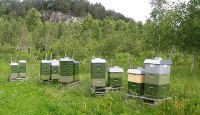
There are several challenges in this calculation which did not play a role in the current BeeBreed population. A considerable number of colonies have swarmed and the performance test was continued with a daughter queen. Controlled mating, a fundamental pillar of breeding value calculation in BeeBreed, is not yet established.
New Developments in Breeding Simulation
We further developed a simulation program in order to predict breeding effects in the honey bee based on the Infinitesimal Animal Model (Fisher, 1918). First results of these simulations were produced and examined and preliminary conclusions could be drawn regarding the optimal size of tested fullsib groups and the importance of mating control. The outcomes of the simulations have also shown that the analysis of other important questions regarding the long-term effects of breeding require simulations based on a more refined Finite Locus Model, the development of which has started in January 2017 and is still going on.
Interactions between Varroa and honeybees mediated through Varroa saliva
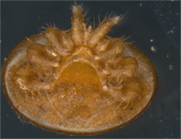
Tools developed by the University of Aberdeen are being used in the SMARTBEE’s program to investigate this relationship. The development of a methodology to extract and analyse saliva from varroa mites was the first phase of the work. As described previously, when saliva collected from a mite is injected into bee larvae or pupae from a Varroa free colony with extremely low DWV there are profound changes in the bee immune response.
We have now completed a detailed analysis of the components of the Varroa saliva and salivary glands (Fig 1), identifying over 1300 different proteins, many of which are potentially potent manipulators of the honey bee immune response. To investigate the role of individual saliva factors in the Varroa-DWV-bee interplay, this information has now been coupled with another tool pioneered at Aberdeen called “gene-knockdown” by RNA-interference (RNAi). A number of genes coding for saliva factors have now been silenced in Varroa mites by RNAi. When these mites, lacking specific saliva factors, feed on developing bee brood there are a number of extreme phenotypes in the bee. The lack of one such saliva factor, for example, causes the bees to discolour and prevents brood from developing into adult bees (Fig 2). This suggests that the role of Varroa saliva is to suppress some arms of the honey bee immune system while simultaneously promoting others. The mite needs to evade the bees’ defence response directly, BUT crucially needs the bee to continue to fight off bacteria and fungi at the bite site that may stop completion of the mite feeding. It is only through the use of these specifically developed techniques and this integrated approach to investigating the Varroa – DWV – bee interplay that we will be able to better understand this relationship and, ultimately, develop tools to disrupt it.
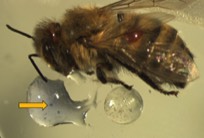
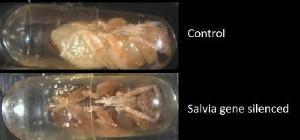
Figure 1. Dissected mite salivary glands compared to a honey bee and Varroa mite. Yellow arrow indicates blue stained glands.
Figure 2. Gene silencing of specific saliva factors in feeding mites causes changes in the bee brood physiology
SMARTBEES at the 45th International Apicultural Congress APIMONDIA
At the 45th International Apicultural Congress APIMONDIA September 29th- October 4th, Istanbul, Turkey, members of SMARTBEES consortium gave a number of talks:
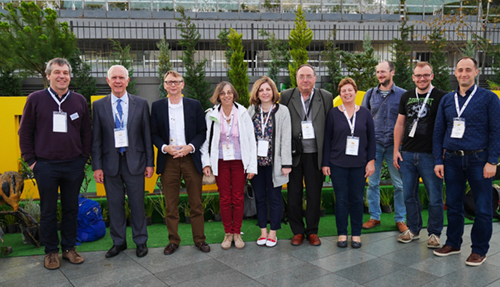
Talks
- The coordinator Prof. Kaspar Bienefeld; Smartbees: The European project for the conservation of endangered honeybee subspecies
- The coordinator Prof. Kaspar Bienefeld; “The impact of the honey bee queen age on her offspring”
- Marina Meixner; “Assessing the diversity of honey bees in Europe”
- Laetitia Papoutsis (talk given by Maria Bouga); “Honey bee conservation areas in Europe”
- Aleksandar Uzunov; “Initiating breeding programs for genetic improvement and preservation of European honey bee populations”
- Jakob Wegener; “Technical progress with the cryopreservation of honeybee genetic resources”
Smartbees consortium members also organized two Round Tables discussions relevant to the project:
1. “CONSERVATION OF LOCAL BEES AND GENETIC POLLUTION “
Moderator: Maria Bouga, Dr. Biologist, honey bee population genetics, Laboratory of Agricultural Zoology and Entomology, Agricultural University of Athens, Greece Coordinator of Apimondia Working Group “Queen rearing and impact on the genetic variability (and health) of productive bee colonies”
Migratory beekeeping and especially queen trade in the opening world markets are contributing factors to loss of honey bee genetic diversity. In addition the transfer of invasive pathogens and pests are real threats as our recent past and present has shown. Hence, the increased globalisation is one of the possible factors in the current bee losses, experienced nearly worldwide. Loss of genetic diversity is connected with the loss of characters that favour adaptation of honey bees to their local conditions. Current experience obtained from several attempts of conservation strategies, has demonstrated high level of different approaches concerning the protection of local honey bee populations. The transfer of this experience may contribute to possible future conservation efforts.
In the first part of the round table discussion 8 short talks were given by invited speakers
- Dr. Karl Crailsheim, Professor, Department of Zoology, Karl-Franzens University Graz, Austria, Apimondia, President of the Scientific Commission Bee Biology)
- Dr. Norman Carreck, Science Director, International Bee Research Association, Laboratory of Apiculture and Social Insects, School of Life Sciences, University of Sussex, United Kingdom
- Dr. Cecilia Costa, CREA - AA, Reggio Emilia, Bologna, Italy
- Dr. Fani Hatjina, Apiculture Division, Institute of Animal Science Hellenic Agriculture Org. "DEMETER" Nea Moudania, Greece
- Dr. Irfan Kandemir, Professor, Department of Biology, Faculty of Science, Ankara University, Ankara, Turkey
- Dr. Per Kryger, Department of Agroecology-Entomology and Plant Pathology, University of Aarhus, Denmark
- Dr. Marina Meixner LLH Bieneninstitut Kirchhain, Kirchhain, Germany
- Dr. Walter S. Sheppard, Professor, Department of Entomology, Washington State University, U.S.A.
2. “BEE HEALTH AND BREEDING BETTER BEES”
Moderator: Dr. Marina Meixner, LLH Bee Institute Kirchhain, Germany
Bee health and colony survival are affected by a multitude factors, among which parasites and pathogens play a prominent role. There is evidence of several feral honey bee populations that have developed disease resistance in the absence of treatment; in addition, numerous breeding programs around the globe exist that focus on improving disease resistance, especially in regard to the parasitic varroa mite. As recent research has also shown that local populations of bees often show better survival in the presence of pathogens than introduced genotypes, efforts to develop sustainable solutions for the improvement of honey bee health should focus on the development of regional breeding incorporating traits related to disease resistance. This is also relevant for regions with introduced A. mellifera beekeeping in Asia where this species is not native.
Short presentations were given by eight invited speakers:
- Dr. Kaspar Bienefeld, LIB Bee Institute Hohen-Neuendorf, Germany
- Dr. Aleksandar Uzunov, LLH Bee Institute Kirchhain, Germany
- Dr. Per Kryger, Aarhus University, Denmark
- Dr. Cecilia Costa, CREA-AA, reggio Emilia, Italy
- Dr. Irfan Kandemir, Ankara University, Turkey
- Dr. Shi Wei, Chinese Academy of Agricultural Sciences, Beijing, China
- Dr. Pierre Giovenazzo, University of Laval, Quebec, Canada
- Dr. Steve Sheppard, Washington State University, USA
The discussion included the following topics:
- The importance of local adaptation for health and survival of honey bee colonies
- Methods for selection and breeding for disease resistance
- Efficient and reliable mating control as an essential component of breeding programs
- development of regional breeding efforts, their implementation and networking
- The impact of such efforts on sustainable improvement bee health
- Costs and economic balance of breeding programs
Read more about Apimondia here.
Partner ICDA won the gold medal for their DVD
"Queen rearing in an intensive system" is the title of a scientific, didactic and technical video film, published in 2017 by the Institute for Beekeeping Research and Development, authors: Adrian Siceanu, PhD. and Eliza Căuia, PhD.
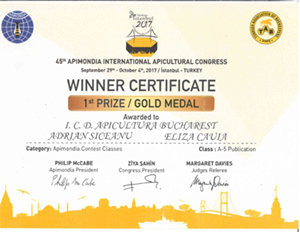
This publication is the result of the activities carried out in the frame of the Romanian and European research projects - ADER 9.1.1/2015, respectively SMARTBEES, grant 613960/2014, to support beekeepers in queen rearing and breeding activities.
The video film, which is 67 minutes long and has a high quality image (full HD), was published on DVD and is available in Romanian and English language.
This video film was produced for all beekeepers that want to produce mated queens for their own needs or for selling, being also an important educational tool for the whole queen rearing process and local bee breeding and conservation efforts.
The video film is structured into the following chapters:
- The queen of the bees;
- Natural swarming;
- Supersedure queens;
- Emergency queens;
- Breeder colony selection for queen and drone rearing;
- Drone rearing;
- Starter colony formation;
- Grafting;
- Introducing and harvesting queen cells in starter colony;
- Preparation of the queen cells frames for finishing colony;
- Introducing queen cells into the finishing colony;
- Queen cells isolation in cages for emerging;
- Queens emerging in normal colonies or in incubator; 14. Mating nuclei formation;
- Other types of mating nuclei;
- Introducing a queen cell or a virgin queen to a nucleus, artificial swarm or queenless colony;
- Nuclei inspection, mated queens harvesting, weighing and caging for delivery;
- Queen bank colonies;
- Introducing a mated queen in a colony;
- Quality queens – strong and productive colonies.
A short advertising presentation can be find on on youtube!
Contact: adrian.siceanu@icdapicultura.ro, eliza.cauia@icdapicultura.ro
More information available on: www.icdapicultura.ro
Contact: adrian.siceanu@icdapicultura.ro, eliza.cauia@icdapicultura.ro
More information available on: www.icdapicultura.ro
SMARTBEES@SICAMM 2018 in Finland
SICAMM, the international organisation for protection of the European dark bee Apis mellifera mellifera will hold their next conference in Mustila, Finland, July 12th – 17th.
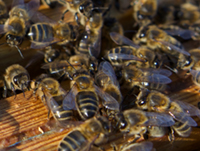
SICAMM was founded in 1995 at Flekkefjord, Norway by beekeepers and scientists from Austria, Denmark, Germany, Norway, Poland, Sweden, Switzerland and the United Kingdom, as an international association devoted to the protection of the European dark honeybee, Apis mellifera mellifera. Participation has since extended to most European countries. The main activity of SICAMM has been the organising of international conferences of which the 13th will take place in Finland next summer.
Impressum / Legal note

